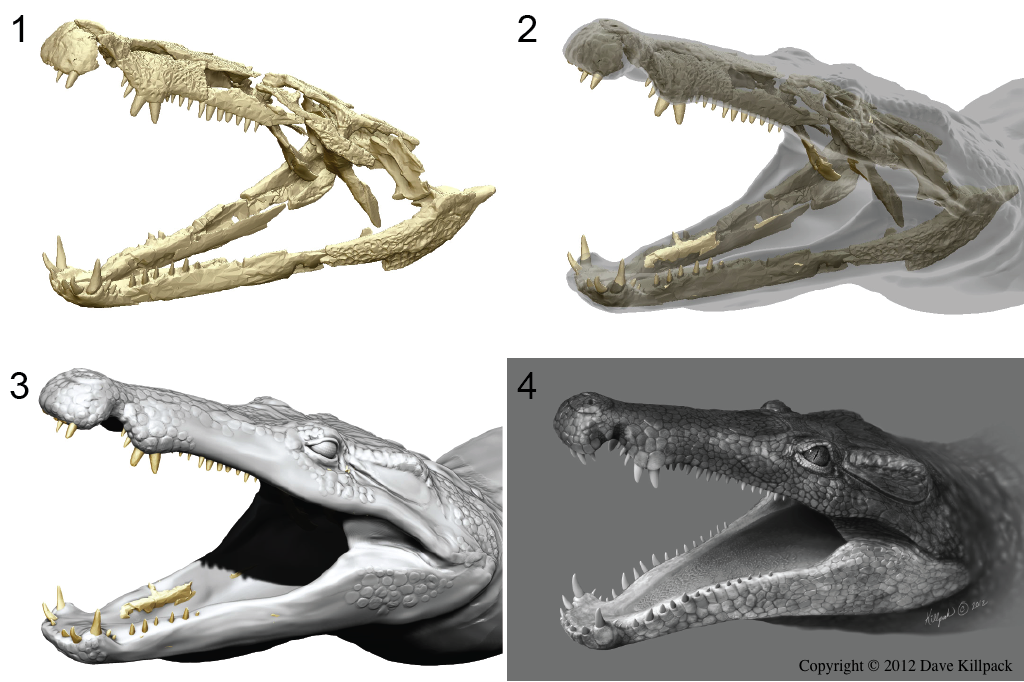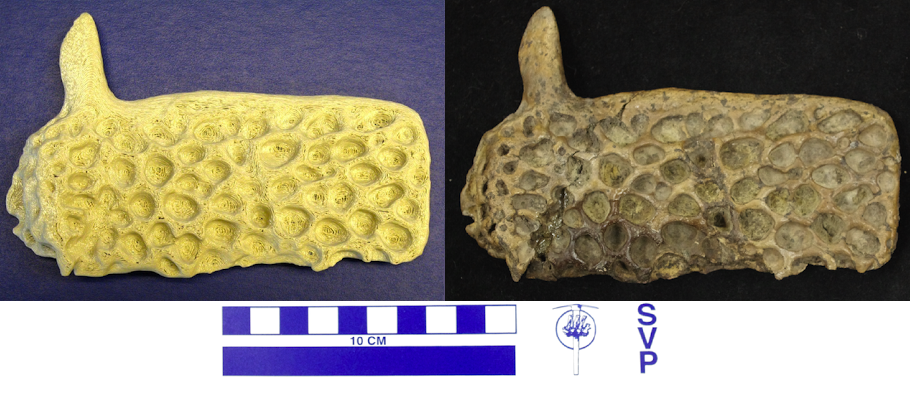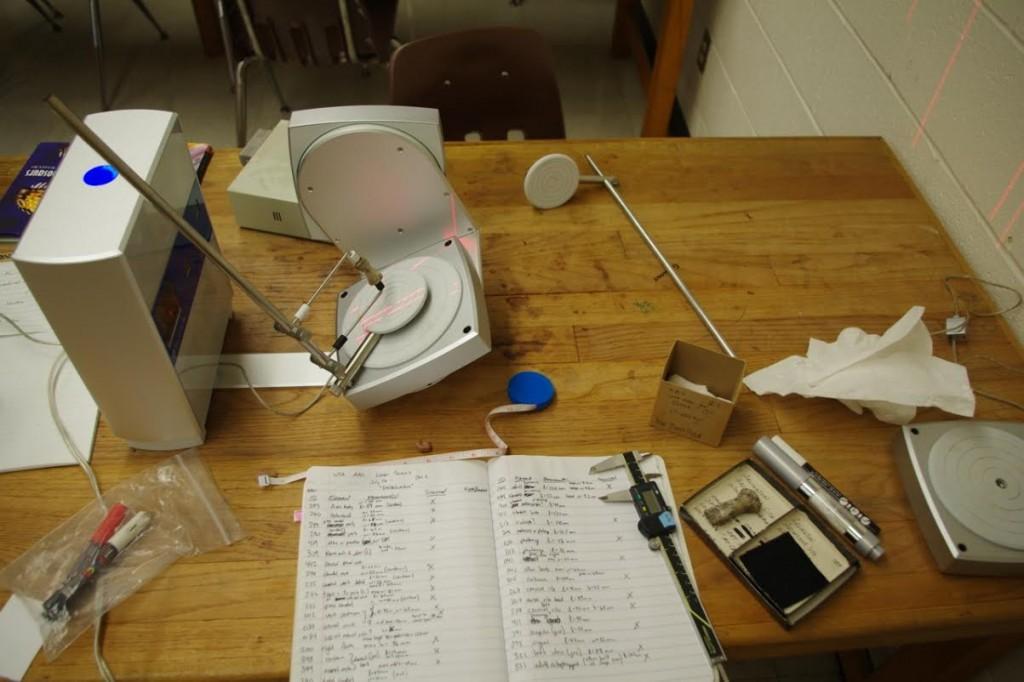
Noto using 3D printed crocodilian bones during an education outreach event. The model in my hand is the fossil crocodile’s arm bone, shrunk to 50% of its actual size.
First appearing over 83 million years ago, were a species of large, predatorial reptiles now known as crocodilians, with their tough skins, sharp teeth and extremely strong jaws. Today, there are around two dozen different species of crocodilians on Earth, most of which are commonly known and referred to as either alligators or crocodiles. These are species that have stood the test of time, and have continued to survive on Earth through all of the environmental, ecological, and climatical changes that have come and gone within the past 83 million years.
While the 23 remaining species of crocodilians have survived for millions of years, this isn’t the case for all of the species. In fact, many are currently classified as critically endangered, while others have gone extinct millions of years ago. Researchers frequently dig up fossilized bones from many of these already extinct species of crocodilians.
Paleontologists at one fossil dig site, called the Arlington Archosaur Site (AAS), in the Dallas-Fort Worth Metroplex tell 3DPrint.com that they have discovered something quite amazing. They have found a new species of extinct crocodilian, and thanks to modern technologies such as 3D printing and 3D scanning, they are in the process of reconstructing what this species originally looked like, even with some bones still undiscovered.
“This is a new species, which means no one has seen it before,” explained Christopher R. Noto, PhD, Assistant Professor of Biological Sciences at the University of Wisconsin-Parkside to 3DPrint.com. “It is new to science. Right now it does not have a formal name, as we are still in the process of describing it for a scientific publication. Based on comparisons with other named fossil crocodilians, we know that it is different from anything that has been described before.”
Noto tells us that the rocks that form the area where they are digging are part of a body of rock known as the Woodbine Formation. This formation is approximately 96-100 million years old, and at that time in the Late Cretaceous period (Cenomanian stage), the environment was a coastal delta plain which included many rivers and swamps. The fossils for this new species of crocodilian come from these swamp deposits.
Unfortunately for researchers, they have not been able to uncover a full skeleton from one creature of this new species, but thanks to laser scanning and 3D printing, they have been able to gradually reconstruct the extinct crocodilian.

The process of reconstructing what the extinct crocodilian may have looked like. A model of the skull was assembled from multiple scans in Blender. This model was used as a guide on where to place the soft tissue. This model was then given realistic skin patterns based on those seen in living crocodilians. (source: Dave Killpack)
“I have been laser scanning specimens and putting them together in Blender, utilizing the ability to copy and mirror, and scale different bones in order to gain a better overall picture of what the extinct crocodile looked like,” explained Noto. “I have been working with a digital artist named Dave Killpack, who works at Illumination Studios in Dallas, to put flesh on the virtual bones and bring these animals to life. I plan on [3D] printing a version of this reconstruction at some point in the future. I also am able to make copies of the specimens easily for study.”
Because the paleontologists have dug up bits and pieces of many different individual creatures, all of different ages and sizes, it is impossible to construct one single skeleton using traditional means. This is where 3D printing and scanning plays a major role. Noto and his team are able to mirror, shrink and enlarge bones in Blender. Dave Killpack, the digital artist then takes the digital files of the bone reconstruction and he puts “virtual flesh” back on the bones.

Comparison of the fossil osteoderm with the printed model (bone that grows in the skin of crocodilians and acts like armor).
Noto uses a Makerbot Replicator 5th Generation 3D printer to print out the replicas of bones so that he can further study them. “I am fairly new to 3D printing but it allows me to make full size or scale models of the scanned fossils for me to study,” he tells us. “All the fossils are stored at the Perot Museum of Nature and Science in Dallas, Texas and I am located in Wisconsin, so printing out copies for myself makes it easier to study these remains when I can’t be at the museum in the collection. Plus I can bring these models with me to show to the public, where the original fossils would be too delicate to let people touch. 3D printing therefore opens up new possibilities in my research and education outreach efforts.”
3D printing, scanning an modeling has really provided a new way of reconstructing skeletal remains of extinct creatures, in a way that is almost as good as finding real bones. It takes time, but without this technology, it would probably have been virtually impossible to reconstruct this newly found species of crocodilian.
As you can see from the photos, the 3D prints come out quite nicely, and are very reliable replicas of the original fossils. What do you think about the use of a MakerBot 3D printer in the process of piecing together fossils of a newly found species? Do you think it will become more commonplace among paleontologists around the world? Discuss in the 3D printing of a newly found creature forum thread on 3DPB.com.
Subscribe to Our Email Newsletter
Stay up-to-date on all the latest news from the 3D printing industry and receive information and offers from third party vendors.
You May Also Like
3D Printing Financials: Fathom Struggles in Financial Quicksand During Critical Transition
Facing a year of key transitions and financial pressures, Fathom (Nasdaq: FTHM) has filed its annual report for 2023 with the U.S. Securities and Exchange Commission (SEC). The document outlines...
Latest Earnings Overview for Australian 3D Printing Firms Titomic and AML3D
Australian 3D printing manufacturing firms Titomic (ASX: TTT) and AML3D (ASX: AL3) reported their financial results for the period from July to December 2023, marking the first half of their...
3D Printing Webinar and Event Roundup: April 7, 2024
Webinars and events in the 3D printing industry are picking back up this week! Sea-Air-Space is coming to Maryland, and SAE International is sponsoring a 3D Systems webinar about 3D...
3D Printing Financials: Unpacking Farsoon and BLT’s 2023 Performance
In the Chinese 3D printing industry, two companies, Farsoon (SHA: 688433) and Bright Laser Technologies, or BLT (SHA: 688333), have recently unveiled their full-year earnings for 2023. Farsoon reported increases...

































